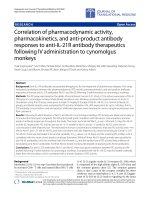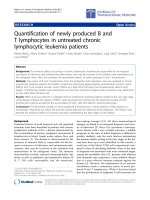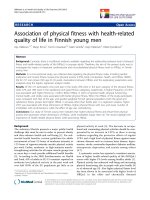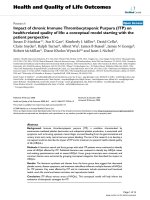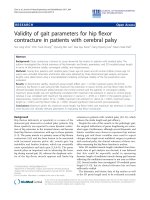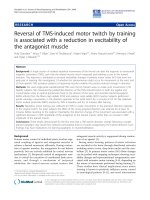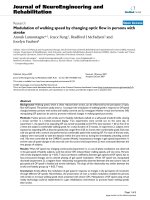báo cáo hóa học:" Association of measured physical performance and demographic and health characteristics with self-reported physical function: implications for the interpretation of self-reported limitations" pdf
Bạn đang xem bản rút gọn của tài liệu. Xem và tải ngay bản đầy đủ của tài liệu tại đây (268.79 KB, 13 trang )
RESEARC H Open Access
Association of measured physical performance
and demographic and health characteristics with
self-reported physical function: implications for
the interpretation of self-reported limitations
Grant H Louie
*
, Michael M Ward
Abstract
Background: Self-reported limitations in physical function often have only weak associations with measured
performance on physical tests, suggesting that factors other than performance commonly influence self-reports.
We tested if personal or health characteristics influenced self-reported limitations in three tasks, controlling for
measured performance on these tasks.
Methods: We used cross-sectional data on adults aged ≥ 60 years (N = 5396) from the Third National Health and
Nutrition Examination Survey to examine the association between the repeated chair rise test and self-reported
difficulty rising from a chair. We then tested if personal characteristics, health indicato rs, body composition, and
performance on unrelated tasks were associated with self-reported limitations in this task. We used the same
approach to examine associations between personal and health characteristics and self-reported difficulty walking
between rooms, contr olling for timed 8-foot walk, and self-reported difficulty getting out of bed, controlling for
repeated chair rise test results.
Results: In multivariate analyses, participants who performed worse on the repeated chair rise test were more
likely to report difficulty with chair rise. However, older age, lower education level, lower serum albumin,
comorbidities, knee pain, and being underweight were also significantly associated with self-reported limitations
with chair rise. Results were similar for difficulty walking between rooms and getting out of bed.
Conclusions: Self-reports of limitations in physical function are influenced by personal and health characteristics
that reflect frailty, and should not be interpreted solely as measured difficulty performing the task.
Background
Physical functioning is a key component of health-
related quality of life (HRQL) [1]. Attention to limita-
tions in physical fu nctioning is increasin g in clinical
practice because these limitations are important to
patients, diminish HRQL, and predict future health out-
comes and the need for care [1-10].
A gold standard method to measure physical function-
ing does not exist. Self-report questionnaires have been
adopted as easily administered instrumen ts that can
capture limitations in a wide spectrum of tasks [11,12].
However, self-report is subjective and may be influenced
by mood, misjudgment of usual ability, or misinterpreta-
tion by the respo ndent. Despite these potential limita-
tions, self-report questionna ires of physical functioning
have face and construct validity [2]. An approach com-
monly used to test the construct validity of self-reported
measures of functioning is to compare responses on
these measures with directly-observed or measured per-
formance on similar tasks. For example, self-reported dif-
ficulty in rising from a chair is tested for correlations
with measured ability to rise from a chair on a timed test.
Although self-reported functioning and performance
on objective physical tests are correlated, these
* Correspondence:
Intramural Research Program, National Institute of Arthritis and
Musculoskeletal and Skin Diseases, National Institutes of Health, Bethesda,
Maryland, USA
Louie and Ward Health and Quality of Life Outcomes 2010, 8:84
/>© 2010 Louie and Ward; licensee BioMed Central Ltd. This is an Open Access article distributed under the terms of the Creative
Commons Attribut ion License ( which permits unrestricted use, distribut ion, and
reproduction in any medium, provided the original work is pr operly cited.
associations are generally weak [13-17]. These studies
often examined associations between multi-item ques-
tionnaires and physical performance test batteries,
which averaged measures of performance over several
domains of functioning [14,15,18-20]. One explanation
for the weak correlations in these studies may be the
problem of compensabilit y: multi-item or summary
measures do not identify which functions are most lim-
ited, the mean result might compensate for isolated lim-
itations, and good performance on some measures
might confound the association between other perfor-
mance measures and their corresponding self-reported
functions. To use p hysical performance tests to assess
the construct validity of self-reported measures, it would
be more appropriate to compare highly specific pairing s
of physical performance tests and self-reported physical
function; that is, how self-reported limitations compare
to measured performance on a corresponding test of the
same task.
An alternative explanation for the modest association
between self-report and physical performance tests may
be that factors other than performance affect self-
reports of limitations. Personal and health characteristics
may influence how different patients appraise the limita-
tions they have.
Despite extensive literature on the use of self-reports
to measure physical functioning, few studies to date
have examined whether factors other than measured
performance on the same tas k influence self-reports.
Our primary objective was to determine if self-reported
limitations in physical functions were associated with
personal and health characteristics, a fter accounting for
measured performance on the same task. To address the
problem of compensability, we analyzed three self-report
tasks (rising from a chair, getting in or out of bed, and
walking between rooms) for which there were corre-
sponding physical performance tests (timed repeated
chair rise and 8-foot walk). This design provided a
unique method with which to assess influences on, and
the meaning of, self-reported limitations.
Methods
Data source and study sample
We analyzed data from the Third National Health and
Nutrition Examination Survey (NHANES III), a national
population-based sample of non-institutionalized indivi-
duals in the United States [21]. In this cross-sectional
study, we included participants aged ≥ 60 years because
only these persons were eligible for an assessment of
physical function. Among this subset, we excluded from
the study individuals (n = 441) who lacked assessment
of physical function at the mobile examination center
(92.3%) or their home (7.7%) by one of the following
three physical performance tests: repeated chair rise,
8-foot walk, or lock and key test. Our final study sample
included 5396 persons. Participants completed the
Household Questionnaire, which included questions on
physical functioning, before they had the physical exami-
nation and performance testing.
Analytic framework
To maximize the specificity of the association between
physical performance tests and self-reported physical
function, we studied performance tests in relation to
their corresponding self-reported functions: 1) repeated
chair rise test and its relationship with self-reporte d dif-
ficulty rising from a chair; 2) repeated chair rise test and
its relationship with self-reported difficul ty getting in or
out of bed; and 3) 8-foot walk test and its relationship
with self-reported difficulty walking between rooms on
the same level. Limitations on eight additional physical
functions were asked, but were not included in the ana-
lysis because they did not have a corresponding physical
performance test administered in NHANES III.
Dependent variables
Ability to perform the three self-reported physical func-
tions of interest was assessed by the following: “Please
tell me if you have no difficulty, some difficulty, much
difficulty or are unable to do these activities at all when
you are by yourself and without the use of aids.” 1)
“Standing up from an armless straight chair?”,2)“Get-
ting in or out of bed?”,and3)“Walking from one room
to another on the same level?”.
Independent variables
Data on six physical performance tests were collected in
NHANES III by trained assessors: repeated chair rise
test, 8-foot walk, lock and key test, shoulder range of
motion, active hip and knee flexion, and timed tandem
stand test [16,22-25]. The repeated chair rise test, an
assessment of lower extremity motor function and pos-
tural control, was a timed test of five consecutive rises
from an armless straight chair. The 8-foot walk test, an
evaluation of gait, was a timed test of usual speed to
walk 8 feet. Time to complete the test (in seconds) was
repre sented as gait speed (in meters per second) by first
converting feet to meters and then dividing by the time
in seconds needed to complete the test. We categorized
performance on both tests into quartiles, with the best-
performing quartile as the reference group.
The lock and key test, a test of eye-hand coordination
and fine motor skills, was a timed test of unlocking a
lock with a key. Internal and external rotations of both
shoulders were s cored as full, partial, or unable to per-
form. Hip and knee flexion were scored similarly. For
analysis, results on the lock and key test were categor-
ized into quartiles, and range of motion of the shoulders
Louie and Ward Health and Quality of Life Outcomes 2010, 8:84
/>Page 2 of 13
and flex ion of the hips and knees were dichotomized as
either full or not, with full as the reference group. We
did not include the timed tandem stand test because
almost all participants attained the maximum allotted
time. Reliability of these physical performance tests has
been reported to be good [16,22-25].
We included covariates available in the data set and
known to be associated with physical function. Demo-
graphic characteristics included age, gender, race-ethnicity,
and education level. We categorized age into five groups
(60-64, 65-69, 70-74, 75-79, and 80 years and older) to
allow for non-linear relationships, and categorized educa-
tion level, recorded as highe st gra de attaine d, into three
groups (0-8, 9-12, and 13-17 years).
The health indicators were current cigarette smoking,
hemoglobin level, serum albumin concentration, knee
pain, and comorbidities. We included current cigarette
smoking, hemoglobin, and serum albumin because they
are indicators of general health [26-29]. Hemoglobin
and serum albumin were used as continuous variables
in the regression models, with associated odds ratios
representing change per 1 gram per deciliter. Knee pain
was included because the functions we studied involved
the lower extremities, and pain may affect physical func-
tion. Knee pain, record ed as tender ness on palpation or
pain with passive motion during the p hysical examina-
tion, was coded as absent, present in one knee, or pre-
sent in both knees. We included comorbidities that may
impact physical function: arthritis, stroke, diabetes melli-
tus, chronic bronchitis, emphysema, asthma, myocardi al
infarction, congestive heart failure, and cancer (exclud-
ing skin cancer). These were collected by self-report.
Body composition was assessed by body mass index
(BMI) and skeletal muscle mass, which are prognostic
indicators of physical function. BMI, measured as weight
in kilograms/height in meters squared, was grouped
using World Health Organization categories of under-
weight (< 18.5 kg/m
2
), normal weight (18.5 - 24.9 kg/
m
2
), overweight (25.0 - 29.9 kg/m
2
), and obesity (≥ 30.0
kg/m
2
) because of its non-linear relationship with physi-
cal function [30,31]. Skeletal muscle mass was deter-
mined from a prediction equation based on bioelectrical
impedance analysis resistance, age, gender, and height.
Following Janssen, we expressed skeletal muscle mass as
skeletal muscle index (SMI) to account for differences
in non-skeletal muscle mass, where SMI = (skeletal
muscle mass/body mass) × 100 [32].
Statistical analysis
Analyses were performed using methods that accounted
for the multistage, clustered sampling of NHANES III.
We used or dinal logistic regression models to examine
the association between specific physical performance
tests and self-reported limitations. In unadjusted models,
the degree of self-rep orted functional limitation was the
dependent variable and the corresponding physical per-
formance test was the independent variable. In adjusted
models, we included age, gender, race-ethnicity, educa-
tion level, arthritis, stroke, diabetes mellitus, chronic
bronchitis, emphysema, asthma, myocardial infarction,
congestive heart failure, cancer, smoking, hemoglobin
level, serum albumin concentration, knee pain, BMI,
and SMI. To determine if other physical performance
tests were associated with any of the three self-reported
functional limitations, we then added the lock and key
test, shoulder range of motion, hip and knee flexion,
and either chair rise test or 8-foot walk test as indepen-
dent variables to each model.
To assess the validity of the proportional odds
assumption in the ordinal logistic regression models, we
examined qualitatively the similarity of odds ratios for
contrasts between each level of the dependent variable
[33]. We represented the associations with a single odds
ratio, since odds ratios for different contrasts were
found to be similar.
Data were missing for education level in 0.7% of cases,
heightin0.2%,weightin0.3%,hemoglobinin5.9%,
serum albumin in 7.8%, bioelectrical impedance analysis
resistance in 17.3%, chair rise test i n 10.3%, 8-foot walk
test in 7.1%, lock and key test in 4.5%, shoulder rotation
in 0.3%, and hip and knee flexion in 6.3%. Data were
missing due to different reasons. During evaluation of
physical functioning, participants who made no attempt
to perform a specific maneuver because of severe physi-
cal limitations were coded as “blank”. We assigned these
participants to the worst performing quartile. Partici-
pants who attempted the task but failed to complete it
were also assigned to the worst performing quartile. On
the other hand, participants who made no attempt to
perform a specific maneuver for reasons unrelated to
physical limitations (e.g. time constraints) were coded as
“blank bu t applicable”. After extensive review by survey
analysts, data believed to be extreme or illogical and
viewed as virtually impossible were also coded as “blank
but applicable” . We treated data coded as blank but
applicable as missing at random. We used the multiple
imputation method with the Markov Chain Monte
Carlo algorithm to impute missing value s [34]. This
allowed us to retain all participants in the analyses, and
provides estimates that are less biased than those of a
complete-case analysi s [35]. Analyses were performed
using SAS version 9.2 (SAS Institute Inc, Cary, NC).
Results
Participant characteristics
Participants had a mean (± standard error of the mean)
age of 70.7 ± 0.2 years (Table 1). Arthritis was the most
common comorbid condition (44.7%), while 12.6%
Louie and Ward Health and Quality of Life Outcomes 2010, 8:84
/>Page 3 of 13
reported having diabetes mellitus, and 11.4% reported
having had a myocardial infarction. At least some diffi-
culty rising from an armless straight chair was reported
by 20.5%; 14.9% reported at least some difficulty getting
in or out of bed, and 8.2% reported at least some diffi-
culty walking between rooms on the same level.
Compared to participants included in the study, those
who were excluded due to lack of assessment of physical
function by physical performance tests had similar
demographic characteristics. They had a mean age of
71.6 ± 0.6 years (vs. 70.7 ± 0.2 years), were mostly
women (58.9% vs. 57.3%), and non-Hispanic white
(81.0% vs. 84.7%). They generally had more comorbid-
ities, with a higher proportion reporting ever been
diagnosed with arthritis (46.7% vs. 44.7%), stroke (11.7%
vs. 6.8%), diabetes mellitus (14.5 % vs. 12.6%), and
chronic bronchitis (12.6% vs. 9.3%).
Association of physical performance tests with self-
reported functional limitations
In the first set of analyses that tested the association of
the repeated chair rise test and self-reported limitations
rising from a chair, worse performance on the chair rise
test was significantly associated with the odds of report-
ing worse limitations (Table 2). In adjusted models, age
was a significant correlate of functional limitat ion, inde-
pendent of perf ormance on the repeated chair rise test,
with progressively higher adjusted odds ratios beginning
with 70-74 year-olds. Lower education level, arthritis,
stroke, congestive heart failure, and cancer were asso-
ciated with a higher odds of worse self-reported limita-
tion, while a higher level of serum albumin was
associated with a lower odds of a worse self-reported
limitation. Participants with bilateral knee pain and
those who were underweight or obese were more likely
to report worse limitations. Gender, current smoking,
hemoglobin level, and SMI were not associated with
self-reported limitation in rising from a chair in this
model.
Results of models predicting self-reported ability to get
in or out of bed were si milar (Table 3). Participants in
the 3
rd
and 4
th
quartiles on the chair r ise test were
more likely to report worse limitations than those in the
best-performing quartile. In the adjusted model, older
age, lower education level, arthritis, stroke, congestive
heart failure, cancer, lower serum albumin level, bilateral
knee pain, and lower BMI were also significantly asso-
ciated with an increa sed odds of worse self-reported
functioning, independent of measured performance on
the chair rise test.
In the third set of models examining s elf-reported
ability to walk between rooms, the 8-foot walk test was
significantly associated with the odds of a wors e level of
self-reported limitation (Table 4). In th e adj usted
model, older age, arthritis, stroke, chronic bronchitis,
congestive heart failure, cancer, and lower serum albu-
min level were significantly associated with self-reported
limitation in walking between rooms, independent of
measured performance on the 8-foot walk test.
Association with other physical performance tests
Self-reported limitation i n rising from a chair was asso-
ciated not only with performance on the chair rise test,
but also w ith performance on the 8-foot walk and with
limitation in hip and knee flexion, when these physical
performance tests were included in the model (Table 5).
Associations with self-reported limitations getting in or
out of bed were similar. Poor performance on the 8-foot
Table 1 Characteristics of the Participants
Percent
Age, y
60-64 25.2
65-69 24.7
70-74 20.5
75-79 14.4
≥ 80 15.2
Women 57.3
Race-ethnicity*
Non-Hispanic White 84.7
Non-Hispanic Black 8.3
Mexican-American 2.3
Other 14.7
Education level
†
,y
≥ 13 27.4
9-12 47.9
0-8 24.7
Arthritis 44.7
Stroke 6.8
Diabetes mellitus 12.6
Chronic bronchitis 9.3
Emphysema 5.9
Asthma 7.1
Myocardial infarction 11.4
Congestive heart failure 7.2
Cancer (excluding skin cancer) 9.4
Current cigarette smoking 15.3
Hemoglobin
‡
, g/dL 13.93 ± 0.03
Serum albumin
‡
, g/dL 4.04 ± 0.02
Body mass index, kg/m
2
< 18.5 2.6
18.5-24.9 35.6
25-29.9 38.7
≥ 30 23.1
Skeletal muscle index
‡
, % 31.11 ± 0.11
*Race-ethnicity self-reported.
†
Highest grade or year of regular school completed .
‡
Plus-minus values are mean ± standard error of the mean.
Louie and Ward Health and Quality of Life Outcomes 2010, 8:84
/>Page 4 of 13
Table 2 Association of Self-Reported Ability to Rise from Armless Straight Chair with Chair Rise Test
Unadjusted Adjusted
OR 95% CI P OR 95% CI P
Chair rise*, sec
Q1 (2.0-11.1) 1.00 1.00
Q2 (11.2-13.6) 1.55 1.13-2.14 0.008 1.31 0.95-1.82 0.10
Q3 (13.7-17.5) 2.67 1.98–3.60 < 0.0001 1.87 1.37-2.56 0.0002
Q4 (17.6-100) 8.83 6.46-12.08 < 0.0001 4.43 3.17-6.20 < 0.0001
Age, y
60-64 1.00
65-69 1.19 0.80-1.78 0.39
70-74 1.62 1.15-2.30 0.006
75-79 1.96 1.39-2.75 0.0001
≥ 80 3.51 2.52-4.90 < 0.0001
Men 1.00
Women 0.87 0.59-1.27 0.46
Race-ethnicity
Non-Hispanic White 1.00
Non-Hispanic Black 0.70 0.53-0.92 0.01
Mexican-American 1.16 0.83-1.62 0.39
Other 1.16 0.68-1.98 0.59
Education, y
≥ 13 1.00
9-12 1.01 0.75-1.34 0.96
0-8 1.37 1.03-1.81 0.03
Arthritis
No 1.00
Yes 2.43 1.99-2.93 < 0.0001
Stroke
No 1.00
Yes 2.58 1.84-3.61 < 0.0001
Diabetes mellitus
No 1.00
Yes 1.13 0.87-1.47 0.37
Chronic bronchitis
No 1.00
Yes 1.07 0.74-1.54 0.73
Emphysema
No 1.00
Yes 1.07 0.66-1.72 0.79
Asthma
No 1.00
Yes 0.83 0.51-1.33 0.44
Louie and Ward Health and Quality of Life Outcomes 2010, 8:84
/>Page 5 of 13
walk test as well as limitations in hip and knee flexion
were significa ntly associ ated with self-reported difficulty
walking between rooms. These findings indicate that
performanc e tests were not uniquely specific in explain-
ing variation in corresponding self-reported functional
limitations.
Complete case analysis
Results of complete case analysis were similar to those
of the main analysis that used multiple imputation of
missing values. In the complete case analyses, self-
reported limitations rising from a chair were associated
not only with worse performance on the repeated chair
rise test, but also with o lder age, current cigaret te
smoking, arthritis, stroke, myocardial infarction, conges-
tive heart failure, lower BMI, knee pain, and lower
serum albumin level. Self-reported limitations getting in
or out of bed were associated with worse performance
on the chair rise test, arthritis, stroke, chronic bronchi-
tis, congestive heart failure, and bilatera l knee pain.
Worse performance on the 8-foot walk test was asso-
ciated with higher odds of self-reported limitations
walking between rooms. Additional significant covariates
included arthritis, stroke, chronic bronchitis, congestive
heart failure, and knee pain. These results indicate that
self-reports were influe nced by personal and health
characteristics and not exclusively by the measured diffi-
culty in performing the task.
Table 2 Association of Self-Reported Ability to Rise from Armless Straight Chair with Chair Rise Test (Continued)
Myocardial infarction
No 1.00
Yes 1.27 0.96-1.68 0.10
Congestive heart failure
No 1.00
Yes 1.68 1.21-2.32 0.002
Cancer (excluding skin cancer)
No 1.00
Yes 1.36 1.01-1.84 0.04
Current smoking
No 1.00
Yes 1.22 0.90-1.65 0.20
Hemoglobin, g/dL 0.94 0.87-1.02 0.11
Serum albumin, g/dL 0.45 0.32-0.63 < 0.0001
Painful knees, no.
0 1.00
1 1.48 0.99-2.21 0.06
2 1.82 1.29-2.56 0.0006
BMI
†
, kg/m
2
< 18.5 2.45 1.60-3.75 < 0.0001
18.5-24.9 1.00
25-29.9 1.18 0.87-1.60 0.27
≥ 30 1.38 1.01-1.88 0.04
SMI
‡
,% 0.98 0.95-1.01 0.18
*Q1, 2, 3, 4 represent 1
st
through 4
th
quartiles, from best performance (Q1) to worst performance (Q4).
†
BMI = body mass index.
‡
SMI = skeletal muscle index.
Louie and Ward Health and Quality of Life Outcomes 2010, 8:84
/>Page 6 of 13
Table 3 Association of Self-Reported Ability to Get In or Out of Bed and Chair Rise Test
Unadjusted Adjusted
OR 95% CI P OR 95% CI P
Chair rise*, sec
Q1 (2.0-11.1) 1.00 1.00
Q2 (11.2-13.6) 1.12 0.74-1.72 0.58 0.98 0.64-1.49 0.91
Q3 (13.7-17.5) 2.27 1.45-3.57 0.001 1.70 1.08-2.69 0.02
Q4 (17.6-100) 6.92 4.88-9.81 < 0.0001 3.84 2.74-5.39 < 0.0001
Age, y
60-64 1.00
65-69 0.93 0.58-1.47 0.75
70-74 1.02 0.71-1.45 0.92
75-79 1.05 0.71-1.57 0.80
≥ 80 1.65 1.13-2.41 0.009
Men 1.00
Women 0.74 0.48-1.12 0.15
Race-ethnicity
Non-Hispanic White 1.00
Non-Hispanic Black 0.70 0.52-0.96 0.03
Mexican-American 1.20 0.83-1.73 0.32
Other 1.08 0.67-1.74 0.76
Education, y
≥ 13 1.00
9-12 1.03 0.72-1.47 0.89
0-8 1.57 1.08-2.27 0.02
Arthritis
No 1.00
Yes 2.75 2.19-3.43 < 0.0001
Stroke
No 1.00
Yes 2.41 1.65-3.54 < 0.0001
Diabetes mellitus
No 1.00
Yes 1.23 0.97-1.56 0.09
Chronic bronchitis
No 1.00
Yes 1.26 0.92-1.72 0.15
Emphysema
No 1.00
Yes 1.40 0.85-2.33 0.19
Asthma
No 1.00
Yes 1.02 0.71-1.46 0.92
Louie and Ward Health and Quality of Life Outcomes 2010, 8:84
/>Page 7 of 13
Discussion
Our findings indicate that self-reported limitations in
physical function were associated with measured perfor-
mance on the task being assessed. Nonetheless, self-
reported physical functioning was influenced also by
personal and health characteristics and not solely by the
measured difficulty in performing the task. These find-
ings indicate that self-report captures information above
and beyond performance on the specific task itself.
Functional limitations were strongly associated with
physical performance tests, particularly for participants
in the worst-performing quartiles. Despite the impor-
tance of physical performance tests, other factors were
independently associated with self-reported phy sical
functioning. Advanced age showed strong graded
associations with limitations in each of the three func-
tions. Participants with comorbid conditions were more
likely to report worse limitations, consistent with prior
reports [36,37]. For all three functions, serum albumin
level was an impo rtant indicator of worse self-reported
functioning, beyond the information on disease burden
provided by the presence of comorbidities. Low serum
albumin level has been associated with an increased
odds of functional limitations in earlier studies [28,29].
Underweight participants had increased risks of self-
reported limitations than their normal weight counter-
parts, consistent with previous reports that low BMI is
associated with functional limitations [31,38]. Pain in
both knees was significantly associated with an increased
odds of limitations rising from a chair and getting in or
Table 3 Association of Self-Reported Ability to Get In or Out of Bed and Chair Rise Test (Continued)
Myocardial infarction
No 1.00
Yes 1.14 0.80-1.62 0.47
Congestive heart failure
No 1.00
Yes 2.11 1.56-2.85 < 0.0001
Cancer (excluding skin cancer)
No 1.00
Yes 1.48 1.10-2.00 0.01
Current smoking
No 1.00
Yes 1.33 0.93-1.91 0.12
Hemoglobin, g/dL 1.02 0.92-1.12 0.74
Serum albumin, g/dL 0.54 0.37-0.78 0.001
Painful knees, no.
0 1.00
1 1.36 0.96-1.92 0.09
2 2.18 1.45-3.28 0.0002
BMI
†
, kg/m
2
< 18.5 2.51 1.36-4.62 0.003
18.5-24.9 1.00
25-29.9 0.93 0.72-1.19 0.57
≥ 30 1.07 0.78-1.46 0.69
SMI
‡
,% 0.99 0.95-1.02 0.46
*Q1, 2, 3, 4 represent 1
st
through 4
th
quartiles, from best performance (Q1) to worst performance (Q4).
†
BMI = body mass index.
‡
SMI = skeletal muscle index.
Louie and Ward Health and Quality of Life Outcomes 2010, 8:84
/>Page 8 of 13
Table 4 Association of Self-Reported Ability to Walk from One Room to Another on Same Level and 8-ft Walk Test
Unadjusted Adjusted
OR 95% CI P OR 95% CI P
8-ft walk*, m/sec
Q1 ( ≥ 0.91) 1.00 1.00
Q2 (0.71-0.90) 1.29 0.62-2.68 0.49 1.25 0.60-2.62 0.55
Q3 (0.54-0.70) 3.23 1.62-6.43 0.0009 2.54 1.16-5.59 0.02
Q4 ( ≤ 0.53) 21.91 11.64-40.24 < 0.0001 14.20 6.67-30.24 < 0.0001
Age, y
60-64 1.00
65-69 1.67 0.85-3.39 0.14
70-74 1.87 1.03-3.40 0.04
75-79 1.50 0.84-2.68 0.17
≥ 80 2.10 1.13-3.92 0.02
Men 1.00
Women 0.91 0.52-1.58 0.73
Race-ethnicity
Non-Hispanic White 1.00
Non-Hispanic Black 1.04 0.73-1.49 0.81
Mexican-American 1.16 0.70-1.92 0.56
Other 0.81 0.45-1.46 0.49
Education, y
≥ 13 1.00
9-12 0.75 0.48-1.17 0.20
0-8 0.94 0.61-1.43 0.77
Arthritis
No 1.00
Yes 2.86 2.17-3.77 < 0.0001
Stroke
No 1.00
Yes 2.26 1.56-3.26 < 0.0001
Diabetes mellitus
No 1.00
Yes 0.98 0.70-1.37 0.89
Chronic bronchitis
No 1.00
Yes 1.64 1.03-2.62 0.04
Emphysema
No 1.00
Yes 1.10 0.54-2.24 0.79
Asthma
No 1.00
Yes 0.88 0.54-1.42 0.60
Louie and Ward Health and Quality of Life Outcomes 2010, 8:84
/>Page 9 of 13
out of bed. These findings suggest that self-reports of
functional limitations represent global perceptions of
frailty, rather than solely an appraisal of limitations on
the task being asked.
Despite extensive literature on this topic, the nature of
the association between physical performance t ests and
self-reported limitations has remained incomple tely char-
acterized. Most prior studies compared a group of physi-
cal performance tests (typically a performance battery)
with multi-item self-report functions [14,15,18-20,39].
For example, Reuben and colleagues found weak associa-
tions between physical function questionnaires and a bat-
tery of physical performance tests in 83 older adults [14].
Myers and colleagues found good correspondence
(defined as > 80% agreement) between a set of 14 physi-
cal performance tests and a set of corresponding self-
reported limitations in only one-third of participants
[13]. We similarly found that physical performance tests
did not correspond exclusively to self-reported limita-
tions. Kempen et al studied the relationship of sociode-
mographic characteristics, performance tests, personality
measures, and cognitive and affective functioning and
self-reported limitations in 753 olde r adults [17]. They
found that associations between physical performance
tests and correspo nding self-reported limitations were
weak, and that some of the discrepancy was explained by
depressive symptom s and self-effica cy. Thes e results sup-
port our findings in suggesting that factors ot her than
Table 4 Association of Self-Reported Abili ty to Walk from One Room to Another on Same Level and 8-ft Walk Test
(Continued)
Myocardial infarction
No 1.00
Yes 0.67 0.43-1.04 0.08
Congestive heart failure
No 1.00
Yes 2.57 1.52-4.33 0.0004
Cancer (excluding skin cancer)
No 1.00
Yes 1.61 1.05-2.48 0.03
Current smoking
No 1.00
Yes 0.97 0.68-1.40 0.89
Hemoglobin, g/dL 0.98 0.87-1.11 0.79
Serum albumin, g/dL 0.33 0.19-0.56 0.0001
Painful knees, no.
0 1.00
1 1.31 0.80-2.14 0.28
2 1.26 0.80-1.97 0.32
BMI
†
, kg/m
2
< 18.5 2.24 0.97-5.16 0.06
18.5-24.9 1.00
25-29.9 1.12 0.76-1.67 0.56
≥ 30 1.14 0.73-1.78 0.57
SMI
‡
,% 1.01 0.97-1.06 0.57
*Q1, 2, 3, 4 represent 1
st
through 4
th
quartiles, from best performance (Q1) to worst performance (Q4).
†
BMI = body mass index.
‡
SMI = skeletal muscle index.
Louie and Ward Health and Quality of Life Outcomes 2010, 8:84
/>Page 10 of 13
performance ca n impact self-repor t. However, while they
accounted for cognitive and affective symptoms, we
found that less well-recognized physical factors, such as
serum albumin level, pain, and BMI were associated with
a higher odds of self-reported limitations.
Physical performance tests that were not specifically
paired to the physical functions studied were also signif-
icantly associated with self-reported limitations. For
example, poor performance on the 8-foot walk test, a
test of gait, was associated with worse self-reported
functioning in rising from a chair and getting in or out
of bed, which are measures of changes in body position.
These associations demonstrate performance tests were
not exclusive correlates o f their specifically paired self-
reported limitations, and that tests of other lower extre-
mity functions (but not of upper extremity functions)
also influence self-reports.
In contrast to many previous studies, we used highly
specificpairingstoprovideamorevalidtestofthe
relationship between physical performance tests and
self-reported physical function, thereby minimizing pro-
blems of compensability and the risk of confounding
across different domains of physical functioning. We
also tested a broad set of personal and health character-
istics as correlates. Moreover, the population-based
national sample increases the generalizability of our
results.
Our study also has some limitations. Because we
wanted to examine self-reported functions for which
there were corresponding physical perfor mance tests, we
were able to examine only two physical performance
tests. Although we do not know if our results apply to
other physical performance tests, the consistency of
results suggests that the findings may be relevant for
other physical functions. We did not have data on
depr essive symptoms, personality measures, fatigue, and
cognitive functioning, each of which can affect physical
functioning [15]. However, our objective was not to
Table 5 Association of related and unrelated physical performance tests with self-reported physical function in
multivariate models*
Self-Reported Physical Function
Model 1 Model 2 Model 3
Rise from Chair Get in or out of Bed Walk across Room
OR
†
95% CI P OR
†
95% CI P OR
†
95% CI P
Chair rise
‡
, sec
Performance Measure Q1 (2.0-11.1) 1.00 1.00 1.00
Q2 (11.2-13.6) 1.55 1.09-2.21 0.01 1.13 0.74-1.72 0.56 0.81 0.38-1.72 0.58
Q3 (13.7-17.5) 1.79 1.28-2.49 0.0007 1.63 1.08-2.46 0.02 0.69 0.36-1.32 0.26
Q4 (17.6-100) 2.94 1.94-4.44 < 0.0001 2.45 1.57-3.82 < 0.0001 1.37 0.69-2.70 0.37
8-foot walk
‡
, m/sec
Q1 ( ≥ 0.91) 1.00 1.00 1.00
Q2 (0.71-0.90) 1.32 0.93-1.87 0.12 1.26 0.82-1.92 0.29 1.37 0.64-2.90 0.42
Q3 (0.54-70) 1.61 1.14-2.28 0.007 1.53 1.00-2.35 0.05 2.21 0.92-5.31 0.07
Q4 ( ≤ 0.53) 2.52 1.73-3.68 < 0.0001 2.58 1.52-4.38 0.0005 7.84 3.73-16.49 < 0.0001
Lock & key
‡
, sec
Q1 (2.0-4.2) 1.00 1.00 1.00
Q2 (4.3-6.3) 0.65 0.50-0.84 0.0008 0.88 0.58-1.31 0.52 0.49 0.25-0.96 0.04
Q3 (6.4-10.3) 1.04 0.79-1.38 0.77 1.18 0.80-1.72 0.41 1.14 0.61-2.13 0.68
Q4 (10.4-60.0) 1.24 0.97-1.59 0.09 1.52 0.99-2.33 0.06 1.13 0.64-1.97 0.68
Shoulder rotation
§
1.24 0.88-1.73 0.22 1.29 0.87-1.91 0.20 1.06 0.64-1.74 0.82
Hip/knee flexion
¶
3.05 1.91-4.87 < 0.0001 2.27 1.48-3.49 0.0002 3.14 1.66-5.95 0.0004
*Values in bold represent physical performance test related to corresponding self-reported physical function.
†
Odds ratio (OR) adjusted for age, gender, education, arthritis, stroke, diabetes mellitus, chronic bronchitis, emphysema, asthma, myocardial infarction, congestive
heart failure, cancer (excluding skin cancer), smoking, hemoglobin, serum albumin, knee pain, body mass index, skeletal muscle index, and physical performance
test.
‡
Q1, 2, 3, 4 represent 1st through 4th quartiles, from best performance (Q1) to worst performance (Q4).
§
Full shoulder rotation versus any limita tion in shoulder rotation.
¶
Full hip and knee flexion versus any limitation in hip and knee flexion.
Louie and Ward Health and Quality of Life Outcomes 2010, 8:84
/>Page 11 of 13
identify all factors that may impact self-reported physi-
cal functioning, but rather to test the relationship
between physical performance and patient factors and
self-reported functioning. Although physical perfor-
mance tests were related to self-reported limitations,
measurement error and the effort-dependence of perfor-
mance measures may have led t o an underestimate of
these associations. Our sample included persons aged ≥
60 years, and we do not know if the associations are
generalizable to younger individuals.
Conclusions
Our results support the validity of self-reported physical
function by finding associations between self-reports
and measured performance on similar tasks. More
important, however, were our findings that these asso-
ciations were neither specific nor exclusive. Personal
and health characteristics of respondents also influenced
self-reported physical function. Our findings caution
against a narrow or strict interpretation of self-reported
limitations in individual tasks. Self-reported limitations
represent a gestalt rather than an appraisal isolated from
its context. Sel f-reports capture information beyond task
difficulty.
Acknowledgements
This research was supported by the Intramural Research Program of the
National Institute of Arthritis and Musculoskeletal and Skin Diseases at the
National Institutes of Health.
Authors’ contributions
GL and MW conceived of the study, designed the study, performed the
statistical analysis, interpreted the results, and drafted the manuscript. All
authors read and approved the final manuscript.
Competing interests
The authors declare that they have no competing interests.
Received: 16 April 2010 Accepted: 13 August 2010
Published: 13 August 2010
References
1. Wilson IB, Cleary PD: Linking clinical variables with health-related quality
of life. A conceptual model of patient outcomes. JAMA 1995, 273:59-65.
2. Applegate WB, Blass JP, Williams TF: Instruments for the functional
assessment of older patients. N Engl J Med 1990, 322:1207-1214.
3. Guralnik JM, Ferrucci L, Simonsick EM, Salive ME, Wallace RB: Lower-
extremity function in persons over the age of 70 years as a predictor of
subsequent disability. N Engl J Med 1995, 332:556-561.
4. Wang L, Larson EB, Bowen JD, van Belle G: Performance-based physical
function and future dementia in older people. Arch Intern Med 2006,
166:1115-1120.
5. Guralnik JM, Simonsick EM, Ferrucci L, Glynn RJ, Berkman LF, Blazer DG,
et al: A short physical performance battery assessing lower extremity
function: association with self-reported disability and prediction of
mortality and nursing home admission. J Gerontol Med Sci 1994, 49:
M85-M94.
6. Mutran E, Ferraro KF: Medical need and use of services among older men
and women. J Gerontol 1988, 43:S162-S171.
7. Wolinsky FD, Johnson RJ: The use of health services by older adults.
J Gerontol 1991, 46:S345-S357.
8. Walter-Ginzburg A, Chetrit A, Medina C, Blumstein T, Gindin J, Modan B:
Physician visits, emergency room utilization, and overnight
hospitalization in the old-old in Israel: the cross-sectional and
longitudinal aging study (CALAS). J Am Geriatr Soc 2001, 49:549-556.
9. Chan L, Beaver S, MacLehose RF, Jha A, Maciejewski M, Doctor JN:
Disability and health care costs in the Medicare Population. Arch Phys
Med Rehabil 2002, 83:1196-1201.
10. Carter SK, Rizzo JA: Use of outpatient physical therapy services by people
with musculoskeletal conditions. Phys Ther 2007, 87:497-512.
11. Feinstein AR, Josephy BR, Wells CK: Scientific and clinical problems in
indexes of functional disability. Ann Intern Med 1986, 105:413-420.
12. Langlois JA, Maggi S, Harris T, Simonsick EM, Ferrucci L, Pavan M, et al: Self-
report of difficulty in performing functional activities identifies a broad
range of disability in old age. J Am Geriatr Soc 1996, 44:1421-1428.
13. Myers AM, Holliday PJ, Harvey KA, Hutchinson KS: Functional performance
measures: are they superior to self-assessments? J Gerontol 1993, 48:
M196-M206.
14. Reuben DB, Valle LA, Hays RD, Siu AL: Measuring physical function in
community-dwelling older persons: a comparison of self-administered,
interviewer-administered, and performance-based measures. J Am Geriatr
Soc 1995,
43:17-23.
15. Cress ME, Schechtman KB, Mulrow CD, Fiatarone MA, Gerety MB,
Buchner DM: Relationship between physical performance and self-
perceived physical function. J Am Geriatr Soc 1995, 43:93-101.
16. Jette AM, Branch LG: Impairment and disability in the aged. J Chronic Dis
1985, 38:59-65.
17. Kempen GI, Steverink N, Ormel J, Deeg DJ: The assessment of ADL among
frail elderly in an interview survey: self-report versus performance-based
tests and determinants of discrepancies. J Gerontol B Psychol Sci Soc Sci
1996, 51:P254-P260.
18. Reuben DB, Siu AL: An objective measure of physical function of elderly
outpatients. The Physical Performance Test. J Am Geriatr Soc 1990,
38:1105-1112.
19. Winograd CH, Lemsky CM, Nevitt MC, Nordstrom TM, Stewart AL, Miller CJ,
et al: Development of a physical performance and mobility examination.
J Am Geriatr Soc 1994, 42:743-749.
20. Gerety MB, Mulrow CD, Tuley MR, Hazuda HP, Lichtenstein MJ, Bohannon R,
et al: Development and validation of a physical performance instrument
for the functionally impaired elderly: the Physical Disability Index (PDI). J
Gerontol 1993, 48:M33-M38.
21. U.S. Department of Health and Human Services (DHHS). National Center for
Health Statistics: Third National Health and Nutrition Examination Survey,
1988-1994, NHANES III. Hyattsville, MD: Centers for Disease Control and
Prevention 1996.
22. Jette AM, Branch LG: Musculoskeletal impairment among the non-
institutionalized aged. Int Rehabil Med 1984, 6:157-161.
23. Williams ME, Hadler NM, Earp JA: Manual ability as a marker of
dependency in geriatric women. J Chron Dis 1982, 35:115-122.
24. Tinetti ME, Williams TF, Mayewski R: Fall risk index for elderly patients
based on number of chronic disabilities. Am J Med 1986, 80:429-434.
25. Nevitt MC, Cummings SR, Kidd S, Black D: Risk factors for recurrent
nonsyncopal falls: a prospective study. JAMA 1989, 261:2663-2668.
26. Vita AJ, Terry RB, Hubert HB, Fries JF: Aging, health risks, and cumulative
disability. N Engl J Med 1998, 338:1035-1041.
27. Yates LB, Djousse L, Kurth T, Buring JE, Gaziano JM: Exceptional longevity
in men: modifiable factors associated with survival and function to age
90 years. Arch Intern Med 2008, 168:284-290.
28. Corti MC, Guralnik JM, Salive ME, Sorkin JD: Serum albumin and physical
disability as predictors of mortality in older persons. JAMA
1994,
272:1036-1042.
29. Salive ME, Coroni-Huntley J, Guralnik JM, Phillips CL, Wallace RB, Ostfeld AM,
et al: Anemia and hemoglobin levels in older persons: relationship with
age, gender, and health status. J Am Geriatr Soc 1992, 40:489-496.
30. World Health Organization: Obesity: preventing and managing the global
epidemic. Report of a WHO convention, Geneva, 1999. WHO technical report
series 894 , Geneva 2000.
31. Mansson NO, Eriksson KF, Israelsson B, Ranstam J, Melander A, Rastam L:
Body mass index and disability pension in middle-aged men–non-linear
relations. Int J Epidemiol 1996, 25:80-85.
Louie and Ward Health and Quality of Life Outcomes 2010, 8:84
/>Page 12 of 13
32. Janssen I, Heymsfield SB, Ross R: Low relative skeletal muscle mass
(sarcopenia) in older persons is associated with functional impairment
and physical disability. J Am Geriatr Soc 2002, 50:889-896.
33. Peterson B, Harrell FE: Partial proportional odds models for ordinal
response models. Appl Statist 1990, 39:205-217.
34. Rubin DB: Multiple Imputation for Nonresponse in Surveys. New York:
John Wiley & Sons, Inc 1987.
35. Greenland S, Finkle WD: A critical look at methods for handling missing
covariates in epidemiologic regression analyses. Am J Epidemiol 1995,
142:1255-1264.
36. Guralnik JM, LaCroix AZ, Everett DF, Kovar MG: Aging in the eighties: the
prevalence of comorbidity and its association with disability. Advance
data from vital and health statistics; no. 170 Hyattsville, Maryland: National
Center for Health Statistics 1989.
37. Fried LP, Guralnik JM: Disability in older adults: evidence regarding
significance, etiology, and risk. J Am Geriatr Soc 1997, 45:92-100.
38. Imai K, Gregg EW, Chen YJ, Zhang P, de Rekeneire N, Williamson DF: The
association of BMI with functional status and self-rated health in US
adults. Obesity 2008, 16:402-408.
39. Alexander NB, Guire KE, Thelen DG, Ashton-Miller JA, Schultz AB,
Grunawalt JC, et al: Self-reported walking ability predicts functional
mobility performance in frail older adults. J Am Geriatr Soc 2000,
48:1408-1413.
doi:10.1186/1477-7525-8-84
Cite this article as: Louie and Ward: Association of measured physical
performance and demographic and health characteristics with self-
reported physical function: implications for the interpretation of self-
reported limitations. Health and Quality of Life Outcomes 2010 8:84.
Submit your next manuscript to BioMed Central
and take full advantage of:
• Convenient online submission
• Thorough peer review
• No space constraints or color figure charges
• Immediate publication on acceptance
• Inclusion in PubMed, CAS, Scopus and Google Scholar
• Research which is freely available for redistribution
Submit your manuscript at
www.biomedcentral.com/submit
Louie and Ward Health and Quality of Life Outcomes 2010, 8:84
/>Page 13 of 13
